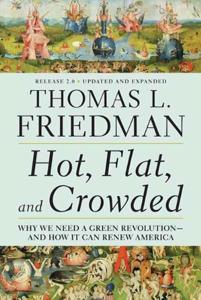
Want to learn the ideas in Hot, Flat, and Crowded better than ever? Read the world’s #1 book summary of Hot, Flat, and Crowded by Thomas L. Friedman here.
Read a brief 1-Page Summary or watch video summaries curated by our expert team. Note: this book guide is not affiliated with or endorsed by the publisher or author, and we always encourage you to purchase and read the full book.
Video Summaries of Hot, Flat, and Crowded
We’ve scoured the Internet for the very best videos on Hot, Flat, and Crowded, from high-quality videos summaries to interviews or commentary by Thomas L. Friedman.
1-Page Summary of Hot, Flat, and Crowded
Introduction
It may seem odd to begin a book about the environment with stories of financial collapse. However, they are closely related because both stem from unsustainable conditions and bad habits. These include underpricing risk, a lack of commitment and accountability, as well as privatizing gains while socializing losses.
Failing to account for risk is a broad problem. The subprime crisis was an example of this, as were the mathematical models that made bundles of “good” and “bad” mortgages look like a safe bet. Then they all defaulted at once.
The mortgage industry was very risky. Lenders were selling mortgages to other companies, and the people responsible for creating those mortgages passed on the risk to others. They got to keep their profits while putting the losses onto someone else. The government had to bail out these banks because they were too big to fail.
The Wilkins Ice Shelf in western Antarctica is a great example of how we are destroying the environment. The shelf began to crumble when energy companies sold hydrocarbons at prices that did not reflect the environmental cost. This led to private gains, but it robbed future generations of theirs because they will live with the consequences of our actions today.
Instead of being the grasshopper generation, we can become the re-generation. The Greatest Generation sacrificed for their country and led by example in environmental protection. We could do the same if we treated environmental damage as a genuine threat to our security and independence.
Where We Are
We are at the beginning of an era that will be defined by energy and climate. As such, there are many challenges we face as a result, including growing demand for scarce resources, transfer of wealth to oil-rich countries and dictatorships, disruptive climate change, energy poverty and accelerating biodiversity loss.
The world is getting crowded. By 2030, there will be an estimated 5 billion people living in cities. Moreover, by 2053 the population will triple from its 1953 level. There are going to be a lot of young people who need stability and jobs on our warming planet.
The flattening of the global economy is a product of technological advancement and the collapse of communism. As more people were able, through the internet and the end of Cold War isolationism, to enter the global market, they demanded middle-class lifestyles that required resources that were in limited supply.
The world is getting hotter and hotter. This is because of greenhouse gases, which are produced by cars and farms. These gases trap heat in the atmosphere, making the planet warmer than it should be. As a result, global temperatures have been rising steadily for over 100 years now. This has caused all kinds of problems for life on earth—everything from floods to droughts to extinction events like what happened with the dinosaurs millions of years ago when an asteroid hit Earth.
China and India are growing rapidly, while governments in the West struggle to keep up with their demand for infrastructure. This is because of a rise in commodities like oil, which has sparked conflicts between countries that have access to this resource. As a result, dictatorships are able to exert more power over other nations when they’re dependent on them for key resources.
The effects of global warming can be seen in the increasing number of environmental crises. One example is Hurricane Katrina. In 2007, the UN Intergovernmental Panel on Climate Change concluded that global warming was an unequivocal reality and would have sudden and irreversible effects, including floods, droughts, heat waves, wildfires, etc. Things could get worse as well because a 10-degree change in temperature will be far more severe than one degree.





